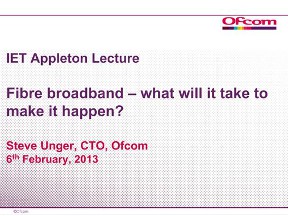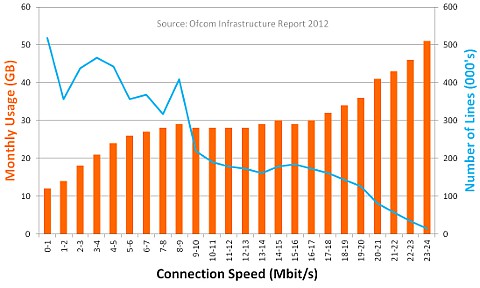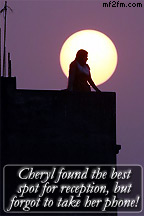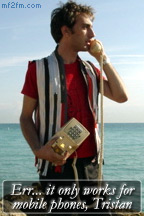Thursday 7 February, 2013, 13:15 - Much Ado About Nothing
Posted by Administrator
Posted by Administrator
 At the IET, Ofcom's chief technology officer, Steve Ungar, gave the annual IET Appleton lecture (parts of which can be viewed on the IET.tv web-site). The title of the lecture was 'Superfast Broadband - what will it take to make it happen', though the opening slide (shown on the right) suggested that Ofcom's views on superfast broadband are clearly that 'superfast equals fibre'. Whether or not wireless (eg LTE) or even satellite services could deliver superfast broadband was discussed in the question and answer session at the end of the presentation at which Dr Ungar indicated that, of course, both had a role to play. But the Freudian slip on the opening slide clearly shows in which direction Ofcom sees the future of high speed broadband.
At the IET, Ofcom's chief technology officer, Steve Ungar, gave the annual IET Appleton lecture (parts of which can be viewed on the IET.tv web-site). The title of the lecture was 'Superfast Broadband - what will it take to make it happen', though the opening slide (shown on the right) suggested that Ofcom's views on superfast broadband are clearly that 'superfast equals fibre'. Whether or not wireless (eg LTE) or even satellite services could deliver superfast broadband was discussed in the question and answer session at the end of the presentation at which Dr Ungar indicated that, of course, both had a role to play. But the Freudian slip on the opening slide clearly shows in which direction Ofcom sees the future of high speed broadband.This slip-up aside, one of the most interesting slides presented by Dr Ungar compared the connection speed that users enjoy with the amount of data they consumed. This diagram is reproduced below (the data is taken from Ofcom's 2012 Infrastructure Report. What it shows are some things that are obvious and others which maybe are not.

The obvious first:
- The chart shows that users with connection speeds of below around 5 Mbps do not consume as much data as those with faster connections. This is relatively obvious because the slower the connection, the lesser the ability to consume data. A user with a 1 Mbps connection would have to use their connection 5 times longer to download the same amount of data as a user with a 5 Mbps connection.
- The chart also shows that those who specifically elect to have a very high speed connection of over 16 Mbps consume more data than those with a slower connection. In effect, those who are paying for higher speed connections (which accounts for approximately 10% of all connections) are doing so because they actually want to use them.
What is not obvious and is quite surprising is that for those with connection speeds in the range of 6 to 16 Mbps, the amount of data they consume each month remains remarkably consistent (at around 28 Gbytes). Having a faster connection does not lead to using more Internet. It thus seems that there is a natural plateau of usage for an average user that is pretty consistent. And that plateau can be reached with a connection speed of 5 Mbps or greater.
Whilst the height of this plateau will inevitably rise as the number of connected devices in homes increases, it does suggest that, for today's British household, a connection speed of 5 Mbps or greater, with a data cap of 40 Gbytes per month (to allow for the occasional peak now and then) would satisfy around 90% of Internet users. Returning to the question of superfast broadband, it therefore seems somewhat gung-ho to be spending hundreds of millions of pounds investing in a fibre-based system which, even Dr Ungar admitted, would only ever reach around two-thirds of the population.
Terrestrial wireless networks (3G) can already deliver the kind of speeds required (HSPA+ offers connection speeds of up to 42 Mbps and even faster if MIMO antennas are used) and tariffs with unlimited data (subject to the usual fair use policies) can be had for around GBP20 per month. Even satellite broadband tariffs, often seen as uneconomical, can offer connection speeds of 20 Mbps with unlimited data download for around GBP35 per month. As things stand, both 3G and satellite networks can provide speeds and packages that exceed what Ofcom has shown to be the average requirement of a typical Internet user of today. As with all such technologies, as time progresses, they will improve and may well stay ahead of requirements.
 What Dr Ungar also pointed out was that the 'last few metres' of almost all Internet connections today are wireless, whether it is the few metres from the WiFi hub to the tablet, or from the cellular mast to the smartphone. To support the kinds of speeds likely to be necessary in the future, it is almost certain that fibre will be needed to deliver connections to wireless access points. In cities these are likely to be homes, streetlamps and anywhere else that a wireless hub can be located. Outside these areas, the availability of fibre will be sparse.
What Dr Ungar also pointed out was that the 'last few metres' of almost all Internet connections today are wireless, whether it is the few metres from the WiFi hub to the tablet, or from the cellular mast to the smartphone. To support the kinds of speeds likely to be necessary in the future, it is almost certain that fibre will be needed to deliver connections to wireless access points. In cities these are likely to be homes, streetlamps and anywhere else that a wireless hub can be located. Outside these areas, the availability of fibre will be sparse.But the good news is, that in rural areas, existing wireless technologies can already deliver the kinds of speeds and data packages that meet the needs of the everyday Internet user. The so-called digital divide between urban and rural areas can already be spanned using existing technologies and services (in fact even Ferrets can do it), all that's needed is for regulators to take a step back and recognise that superfast broadband is not always necessary and that, by association, fibre is not necessarily the solution to every ill. A more balanced investment strategy that takes into account the strengths and weaknesses of each of the possible Internet connectivity solutions, and levels the playing field between them, might yield much greater public satisfaction.
add comment
( 1652 views )
| permalink
| 



 ( 2.9 / 2059 )
( 2.9 / 2059 )




 ( 2.9 / 2059 )
( 2.9 / 2059 )
Sunday 23 December, 2012, 23:02 - Radio Randomness, Satellites, Much Ado About Nothing
Posted by Administrator
It seems there are very few songs which touch on the topic of satellite communications unless you count:Posted by Administrator
- Sleeping Satellite by Tasmin Archer;
- Satellite by Lena (Germany's Eurovision winner in 2010); and
- Satellite by Oceanlab.
I'm just talking to a satellite,
Twenty thousand miles up in the sky each night
Taken from Electric Light Orchestra's Calling America.
There’s also:
I saw two shooting stars last night,
I wished on them but they were only satellites,
It's wrong to wish on space hardware.
I wish, I wish, I wish you'd care.
Taken from Kirsty Macoll's New England.
So it was nice to be alerted to a piece of work which is not only about satellites, but is very specifically endorsing the use of C-Band satellite services (3400 – 4200 MHz) over and above the use of Ku-Band (10700 – 12500 MHz) in sub-Saharan Africa where C-Band reception is more reliable than Ku-Band due to the fact that it deals with rain fading much better than Ku-Band does.
The song is by Cameroonian artist Wes. In it, he laments the loss of his Ku-band equipment, and the main thrust of the song is that he is short of some solder with which to complete the installation of his new C-Band parts. The video has him stood in front of his non-functional C-Band dish whilst his team try to dance their way into fixing the problem. Eventually they set off on a trek to try and get him some solder as the dancing, no matter how energetic, is clearly not working.
The only odd thing is that there is an Asian lady who, all the way through the song, keeps going on about her blasted spade. Still, it all adds to the ambiance.
The song is called ‘Soldery Song’, and you will need to watch the video whilst at the same time reading the lyrics below as it is quite hard to follow what he is saying due to his strong African English accent (the spade lady's incessant moaning about her spade is shown in brackets)...
SOLDERY SONG – WES
Soldery Song – Wes by jibou
(My Spade, where’s my spade?)
Soldery song: me need a solder
Me got me some parts, now it's me too,
Old part me chuck, and new me part, yeh?
Soldery song: me need me a soldery solder
Me got me some parts, now it's me too,
Old part me chuck, and me new part, yeh?
I throw a my Ku away, melt some solder, done my way
I throw a my Ku away, melt some solder, done my way
Bring us C-band way (with a spade?)
One-a-where they can go?
Hey, I meant to check.
(Spade, yeh, yeh, yeh, yeh!) x 2
Soldery song: hoo hoo hoo hoo hoo, me need a solder
Me got me some parts, now it's me too,
Old part me chuck and new me part, yeh?
I throw a my Ku away, melt some solder, done my way
I throw a my Ku away, melt some solder, done my way
Bring us C-band way (with a spade?)
One-a-where they can go?
Hey, I meant to check.
(Spade, yeh, yeh, yeh, yeh!) x 2
No more can I Ku, new me parts C-band
No more can I Ku, new me parts knackered!
No more can I Ku, new me parts C-band
No more can I Ku, new me parts knackered!
No more can I Ku, new me parts C-band
No more can I Ku, new me parts knackered!
I throw a my Ku away, melt some solder, done my way x 4
Bring us C-band way (with a spade?)
One-a-where they can go?
(Spade, yeh, yeh, yeh, yeh!)
Bring us C-band way (with a spade?)
One-a-where they can go?
Hey, I meant to check.
No more can I Ku, new me parts C-band
No more can I Ku, new me parts knackered!
No more can I Ku, new me parts C-band
No more can I Ku...
(Spade, yeh, yeh, yeh, yeh!)
Perhaps some kind Wireless Waffle reader could purchase some solder and send it to Wes to get his C-band equipment up and working. Oh, and whilst you’re at it, give the poor lady a spade too.
Monday 4 June, 2012, 21:29 - Much Ado About Nothing
Posted by Administrator
A friend recently alerted us to the fact that 'fjarskiptastofnun' is the Icelandic word for 'telecommunications'. Is this the best word for 'telecommunications' you have ever heard? Maybe, then again maybe not. Here are Wireless Waffle's favourite foreign phrases for the word 'telecommunications'.Posted by Administrator
Armenian: Հեռահաղորդակցման
Finnish: tietoliikenne
Georgian: სატელეკომუნიკაციო
Hungarian: távközlés
Irish: teileachumarsáide
Maltese: telekomunikazzjonijiet
Nonsense: dreskidooloo beepbeep
Swahili: mawasiliano ya simu
Vietnamese: viễn thông
Welsh: telathrebu by there, see?
 Ofcom has recently published a leaflet outlining how mobile subscribers can go about maximising their mobile signal with a view to getting the best possible coverage. The leaflet covers issues such as checking coverage first, before buying a phone (shops have on-line coverage checkers available), trying out different operators (by testing different SIM cards) and has a few technical measures such as the use of Femtocells (tiny mobile base stations you can install in your own home) and UMA (carrying your voice traffic over WiFi when you're in the coverage of a suitable hotspot).
Ofcom has recently published a leaflet outlining how mobile subscribers can go about maximising their mobile signal with a view to getting the best possible coverage. The leaflet covers issues such as checking coverage first, before buying a phone (shops have on-line coverage checkers available), trying out different operators (by testing different SIM cards) and has a few technical measures such as the use of Femtocells (tiny mobile base stations you can install in your own home) and UMA (carrying your voice traffic over WiFi when you're in the coverage of a suitable hotspot).This is all well and good, and reasonable advice, but it doesn't cover how you might go about getting a better signal if you are stuck in an area with poor coverage. So here's the (new look!) Wireless Waffle guide to practical things you can do to get a better signal (and things that don't work).
 Get high! By far the best way to improve your chances of getting a good signal is to get your phone as high as possible. Signals upstairs will be better than signals downstairs. Signals at the top of a hill will be better than at the bottom. Standing on the roof of your car will get a better signal than sitting inside it (not recommended if you are a bit on the heavy side). Height is the number one way to boost your signal.
Get high! By far the best way to improve your chances of getting a good signal is to get your phone as high as possible. Signals upstairs will be better than signals downstairs. Signals at the top of a hill will be better than at the bottom. Standing on the roof of your car will get a better signal than sitting inside it (not recommended if you are a bit on the heavy side). Height is the number one way to boost your signal.Get out! The Ofcom paper mentions this too, but doesn't point out how big a difference it can make. Buildings can shield mobile signals by anything up to a factor of 50. Standing outside will circumvent this shielding and can make a big difference in your chances of success.
Get moving! Buildings not only shield signals inside them but can block signals from passing through them. Other big obstructions such as gasometers, walls, and even trees and cars
can also block signals. As you are unlikely to know which direction the mobile signal you are trying to receive is coming from, you may inadvertently be stood in a position where it is being blocked. Move around (in particular walk around a building) whilst checking the signal on your phone to see if there is a spot where it suddenly comes to life.
 Get naked! Whilst we would love to see people walking around buildings in the nude to try and get a better phone signal, by this we mean taking off any covers, shells or other accoutremenets which adorn your phone. Some covers can contain metal elements which can deflect mobile signals, especially if they end up covering up the antenna on your phone. Operating your phone 'naked' will ensure that it's antenna is not blocked or covered in any way and can further improve performance.
Get naked! Whilst we would love to see people walking around buildings in the nude to try and get a better phone signal, by this we mean taking off any covers, shells or other accoutremenets which adorn your phone. Some covers can contain metal elements which can deflect mobile signals, especially if they end up covering up the antenna on your phone. Operating your phone 'naked' will ensure that it's antenna is not blocked or covered in any way and can further improve performance.Get clear! Most electrical devices, especially computers, TVs, set top boxes and other electronic gizmos give off weak radio interference. The amount they give off is limited by law, but in close proximity it can be enough to upset mobile reception. Make sure you are as far as possible away from any electronic equipment and the interference they generate should be too weak to cause reception problems.
Get plugged in! If your phone has option to connect an external antenna (such as via a car-kit) it might be feasible to connect an free-standing aerial (such as these) to it. The antennas inside phones are a compromise in size, designed to peform as well as possible given the small space in which they have to fit. Plugging in a proper, full-size, external aerial will boost signals, especially if the aerial concerned is high up, outside and clear of any blockages.
Of course, these are the easy answers. There are some more technical solutions that require a bit of effort, like the soup can booster antenna (no, not two cans and piece of string) which really work. As well as things that do help, there are a number of things that don't...
 Power Strip Antenna Boosters and similar devices that you stick on your phone that claim to be able to improve its performance. Anything that doesn't plug into your phone but just sticks to it is highly unlikely to do anything other than leave a sticky patch when you remove it.
Power Strip Antenna Boosters and similar devices that you stick on your phone that claim to be able to improve its performance. Anything that doesn't plug into your phone but just sticks to it is highly unlikely to do anything other than leave a sticky patch when you remove it.Passive repeaters are a bit of a grey area. Properly installed they may be able to provide some boost in signal indoors, by taking the signal that is received outside and relaying it to the inside. The increase is only likely to be noticeable if you mount the external antenna as high as possible, use very high quality cable to connect the two ends, and stand right next to the internal antenna.
Active repeaters are also a grey area, but for a different reason. They do actually work, and can improve mobile signals if properly installed. But, and it's a big BUT, they are illegal to operate. The only people licensed to use them are the mobile operators themselves. Anyone else using one is breaking the law. Further, if they are badly installed, they can cause interference to the mobile networks actually making reception significantly worse, not just for you, but for everyone else in the area too!
So hopefully you now have a much better idea of what works and what doesn't and can amaze your friends by shouting out the mantra of 'get high, get moving, get naked and get clear' if they are suffering reception problems. They are sure to understand what you mean as you couldn't possibly be misinterpreted, could you?

